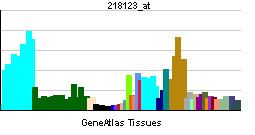Species Human Entrez 56683 | Human Mouse Ensembl ENSG00000159079 | |
 | ||
Aliases C21orf59, C21orf48, CILD26, FBB18, Kur, chromosome 21 open reading frame 59 External IDs MGI: 1915251 HomoloGene: 10941 GeneCards: C21orf59 | ||
C21orf59 is a protein of unknown function. It is of interest in part for its association with various diseases. It has been found in high levels in the bone marrow of patients with a negative prognosis of acute myeloid leukemia and an abnormal karyotype. Male Alzheimer's patients have shown a decrease in expression of C21orf59 in their blood cells. The C21orf59 gene lies within the critical region of Down Syndrome. There are no clear paralogs in humans, but the gene has homologues widely conserved among animals, fungi, and algae.
Contents
Gene
C21orf59 is a gene found on the 21st chromosome at 21q22.1. A total of thirteen splice variants have been found, but only eleven protein coding ones. The most common form of C21orf59 mRNA has 1427 base pairs broken into seven exons. Its closest neighbors on the chromosome are TCP10L, FAM176C, LOC100506185, OR7E23P, and SYNJ1.
Gene Expression
The C21orf59 primary sequence is found in high quantity in most tissues. Some tissues with notable less expression are the ganglions, the heart, and the liver. It is suspected C21orf59 is found in the brain early in development due to the two achaete-scute complex homologue transcription factor binding sites found in the promoter.
Protein
The C21orf59 primary sequence consists of 290 amino acids with mass 33.093 kDa. The isoelectric point is 7.283, but is reduced to 5.86 if fully phosphorylated. Several post-translational modifications have been found by mass spectroscopy: five phosphorylation sites, one methylation site, one ubiquitination site, and one acetylation site. Most of these modifications happen in the latter half of the protein.
Structure
The majority of the protein consists of the domain DUF2870. This domain is primarily found in homologues of C21orf59, but also in other uncharacterized proteins, and it contains the majority of the sites that are modified after translation. The protein is predicted to consist mostly of alpha helices and lack beta strands.
Localization
C21orf59 has been shown to localize to the cytosol and the nucleus, but has been predicted, albeit with less strength, to localize to the cytoskeleton, peroxisome, and the mitochondria.
Interactions
Through mass spectrometry, interactions with SUMO2, a post-translational modification protein resembling ubiquitin, and Ubiquitin C have been identified. Through two-hybrid experiments, an interaction with MAPK6, a protein kinase, has been found.
Recent Studies
A study in zebrafish has shown C21orf59 is found in high concentrations in the Kupffer vesicles, and is intracellularly localized to the basal body of the cilia. Zebrafish mutant in C21orf59 homologue have less functional cilia and distorted right/left symmetry, suggesting the role of c21orf59 is important in developing a normal body shape.
